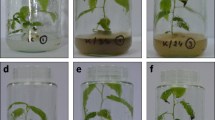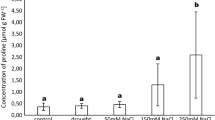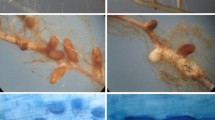Abstract
Poplars are among the few tree genera that can develop both ectomycorrhizal (ECM) and arbuscular (AM) associations; however, variable ratios of ECM/AM in dual mycorrhizal colonizations were observed in the roots of a variety of poplar species and hybrids. The objective of our study was to analyze the effect of internal and external factors on growth and dual AM and ECM colonization of poplar roots in three 12–15-year-old common gardens in Poland. We also analyzed the abundance of nonmycorrhizal fungal endophytes in the poplar roots. The Populus clones comprised black poplars (Populus deltoides and P. deltoides × Populus nigra), balsam poplars (Populus maximowiczii × Populus trichocarpa), and a hybrid of black and balsam poplars (P. deltoides × P. trichocarpa). Of the three sites that we studied, one was located in the vicinity of a copper smelter, where soil was contaminated with copper and lead. Poplar root tip abundance, mycorrhizal colonization, and soil fungi biomass were lower at this heavily polluted site. The total mycorrhizal colonization and the ratio of ECM and AM colonization differed among the study sites and according to soil depth. The influence of Populus genotype was significantly pronounced only within the individual study sites. The contribution of nonmycorrhizal fungal endophytes differed among the poplar clones and was higher at the polluted site than at the sites free of pollution. Our results indicate that poplar fine root abundance and AM and ECM symbiosis are influenced by environmental conditions. Further studies of different site conditions are required to characterize the utility of poplars for purposes such as the phytoremediation of polluted sites.



Similar content being viewed by others
References
Barker SJ, Duplessis S, Tagu D (2002) The application of genetic approaches for investigations of mycorrhizal symbioses. Plant Soil 244:85–95
Baum Ch, Makeschin F (2000) Effect of nitrogen and phosphorus fertilization on mycorrhizal formation of two poplar clones (Populus trichocarpa and P. tremula × tremuloides). Plant Nutr Soil Sci 163:491–497
Baum C, Schmid K, Makeschin F (2000) Interactive effects of substrates and ectomycorrhizal colonization on growth of a poplar clone. J Plant Nutr Soil Sci 163:221–226
Beauchamp VB, Stromberg JC, Stutz JC (2005) Interactions between Tamarix ramosissima (saltcedar), Populus fremontii (cottonwood), and mycorrhizal fungi: effects on seedlings growth and plant species coexistence. Plant Soil 275:221–231
Blaudez D, Kohler A, Martin F, Sanders D, Chalot M (2003) Poplar metal tolerance protein 1 confers zinc tolerance and is an oligomeric vacuolar zinc transporter with an essential leucine zipper motif. Plant Cell 15:2911–2928
Borghi M, Tognetti R, Monteforti G, Sebastiani L (2008) Responses of two poplar species (Populus alba and Populus × Canadensis) to high copper concentration. Environ Exp Bot 62:290–299
Brundrett M, Murase G, Kendrick B (1990) Comparative anatomy of roots and mycorrhizae of common Ontario trees. Can J Bot 68:551–578
Bugała W (1973) Systematyka i zmienność. In: Białobok S. (ed) Topole, Nasze drzewa leśne, vol.12, PWN
Chen YL, Brundrett MC, Dell B (2000) Effects of ectomycorrhizas and vesicular–arbuscular mycorrhizas, alone or in competition, on root colonization and growth of Eucalyptus globules and E. urophylla. New Phytol 146:545–556
Conn Ch, Dighton J (2000) Litter quality influences on decomposition, ectomycorrhizal community structure and mycorrhizal root surface acid phosphatase activity. Soil Biol Biochem 32:489–496
Djingova R, Wagner G, Kuleff I (1999) Screening of heavy metal pollution in Bulgaria using Populus nigra ‘Italica’. Sci Tot Environ 234:175–184
Dominik T (1958) Study of mycotrophism of the genus Populus. Pr Inst Bad Leśn 181:117–172
Entry JA, Rygiewicz PT, Watrud LS, Donnely PK (2002) Influence of adverse soil conditions on the formation and function of arbuscular mycorrhizas. Adv Environ Res 7:123–138
Gadd GM (1993) Interactions of fungi with toxic metals. New Phytol 124:25–60
Gardner JH, Malajczuk N (1988) Recolonization of rehabilitated bauxite mine sites in Western Australia by mycorrhizal fungi. For Ecol Manage 24:24–42
Gehring CA, Mueller C, Whitham TG (2006) Environmental and genetic effects on the formation of ectomycorrhizal and arbuscular mycorrhizal associations in cottonwoods. Oecol 149:158–164
Gonçalves MT, Martins-Loução MA (1996) Mycotrophic conditions of Populus nigra and P. × euramericana. Evolution of endo vs ectomycorrhiza. Evaluation of endo vs ectomycorrhizal. In: Azcòn-Aguilar C, Barea JM (eds) Mycorrhizas in integrated systems from genes to development. Proceedings of the Fourth European Symposium on Mycorrhizas. ECSC-EC-EAEC, Brussels, pp 118–120
Jumpponen A, Trappe JM (1998) Dark septate endophytes: a review of facultative biothropic root colonizing fungi. New Phytol 140:295–310
Kabata-Pendias A, Pendias H (1993) Biochemia pierwiastków śladowych. Wyd Nauk PWN, Warszawa
Kaldorf M, Fladung M, Muhs HJ, Buscot F (2002) Mycorrhizal colonization of transgenic aspen in a field trial. Planta 214:653–660
Kelly JJ, Häggblom MM, Tate RL (2003) Effects of heavy metal contamination and remediation on soil microbial communities in the vicinity of a zinc smelter as indicated by analysis of microbial community phospholipid fatty acid profiles. Biol Fertil Soils 38:65–71
Khasa PD, Chakravarty P, Robertson A, Thomas BR, Dancik BP (2002) The mycorrhizal status of selected poplar clones introduced in Alberta. Biom Bioenerg 22:99–104
Kloke A. (1980) Orientierungsdaten für tolerierbare Gesamtgehalte einiger Elemente in Kulturböden. Mitt. VDLUFA H.
Kormanik PP, McGraw AC (1982) Quantification of vesicular–arbuscular mycorrhizae in plant roots. In: Schenck NC (ed) Methods and principles of mycorrhizal research. Amer Phytopathol Soc, St. Paul, pp 37–45
Krpata D, Peintner U, Langer I, Fitz WJ, Schweiger P (2008) Ectomycorrhizal communities associated with Populus tremula growing on heavy metal contaminated site. Mycol Res 112:1069–1079
Laureysens I, De Temmerman L, Hastir T, Van Gysel M, Ceulemans R (2005) Clonal variation in heavy metal accumulation and biomass production in a poplar coppice culture. II. Vertical distribution and phytoextraction potential. Environ Pollut 133:541–551
Lingua G, Franchin C, Todeschini V, Castiglione S, Biondi S, Burlando B, Parravivini V, Torrigiani P, Berta G (2008) Arbuscular mycorrhizal fungi differently affect the response to high zinc concentrations of two registered poplar clones. Environ Pollut 153:137–147
Lodge DJ (1989) The influence of soil moisture and flooding on formation of VA-endo- and ectomycorrhizae in Populus and Salix. Plant Soil 117:243–253
McGonigle TP, Miller MH, Evans DG, Fairchild GL, Swan JA (1990) A new method, which gives an objective measure of colonization of roots by vesicular–arbuscular mycorrhizal fungi. New Phytol 115:495–501
Meharg AA, Cairney JWG (2000) Co-evolution of mycorrhizal symbionts and their hosts to metal-contaminated environments. Adv Ecol Res 30:69–112
Mexal J, Reid CPP (1973) The growth of selected mycorrhizal fungi in response to induced water stress. Can J Bot 51:1579–1588
Miller SP (2000) Arbuscular mycorrhizal colonization of semi-aquatic grasses along a wide hydrologic gradient. New Phytol 145:145–155
Miller SP, Bever JD (1999) Distribution of arbuscular mycorrhizal fungi in stands of the wetland grass Panicum hemitomon along wide hydrologic gradient. Oecologia 119:586–592
Monclus R, Dreyer E, Villar M, Delmotte M, Delay D, Petit JM, Barbaroux C, Le Thiec D, Brechet C, Brignolas F (2006) Impact of drought on productivity and water use efficiency in 29 genotypes of Populus deltoides × Populus nigra. New Phytol 169:765–777
Montgomery HJ, Monreal CM, Young JC, Seifert KA (2000) Determination of soil fungal biomass from soil ergosterol analyses. Soil Biol Biochem 32:1207–1217
Moyersonen B, Fitter AH, Alexander IJ (1998) Spatial distribution of ectomycorrhizas and arbuscular mycorrhizas in Korup National Park rain forest, Cameroon, in relation to edaphic parameters. New Phytol 139:311–320
Neville J, Tessier JL, Morrison I, Scarratt J, Canning B, Klironomos JN (2002) Soil depth distribution of ecto- and arbuscular mycorrhizal fungi associated with Populus tremuloides within a 3-year-ild boreal forest clear-cut. Appl Soil Ecol 19:209–216
Paul EA, Clark FE (1996) Soil microbiology and biochemistry. Academic Press, San Diego
Postma JWM, Olsson PA, Falkengren-Grerup U (2007) Root colonisation by arbuscular mycorrhizal, fine endophytic and dark septate fungi across a pH gradient in acid beech forests. Soil Biol Bioch 39:400–408
Querejeta JI, Egerton-Warburton LM, Allen MF (2009) Topographic position modulates the mycorrhizal response of oak trees to interannual rainfall variability. Ecology 90:649–662
Rachwał L, De Temmerman LO, Istas JR (1992) Differences in the accumulation of heavy metals in poplar clones of various susceptibility to air pollution. Arbor Kórnickie 37:101–111
Rossel D, Tarradellas J, Bitton G, Morel JL (1997) Use of enzymes in ecotoxicology: a case for dehydrogenase and hydrolytic enzymes. In: Tarradellas J, Bitton G, Rossel D (eds) Soil ecotoxicology. CRC, Boca Raton, pp 179–192
Routsalainen AL, Markkola A, Kozlov MV (2007) Root fungal colonization in Deschampsia flexuosa: effect of pollution and neighbouring trees. Environ Pollut 147:723–728
Sebastiani L, Scebba F, Tognetti R (2004) Heavy metal accumulation and growth responses in poplar clones Eridano (Populus deltoides x maximowiczii) and I-214 (P. × euramericana) exposed to industrial waste. Environ Exp Bot 52:79–88
Shi W, Bischoff M, Turco R, Konopka A (2002) Long-term effects of chromium and lead upon the activity of soil microbial communities. Appl Soil Ecol 21:169–177
Smith SE, Read DJ (2008) Mycorrhizal symbiosis. Academic, London
Snedecor W, Cochran WG (1976) Statistical methods, 6th edn. The Iowa State University Press, Ames, pp 327–329
Tagu D, Rampant PF, Lapeyrie F, Frey-Klett P, Vion P (2001) Variation in the ability to form ectomycorrhizas in the F1progeny of an interspecific poplar (Populus spp.) cross. Mycorrhiza 10:237–240
Tagu D, Bastien C, Faivre-Rampant P, Garbaye J, Vion P, Villar M, Martin F (2005) Genetic analysis of phenotypic variation for ectomycorrhiza formation in an interspecific F1 poplar full-sib family. Mycorrhiza 15:87–91
Truszkowska W (1953) Mycotrophy of Alneta in the Białowieża National Park and in Domaszyn near Wrocław. Acta Soc Bot Pol 22:737–752
van der Heijden EW, Vosatka M (1999) Mycorrhizal associations of Salix repens L. communities in succession of dune ecosystems. Part II. Mycorrhizal dynamics and interactions of ectomycorrhizal and arbuscular mycorrhizal fungi. Can J Bot 77:1833–1841
van der Heijden EW, de Vries FD, Kuyper TW (1999) Mycorrhizal associations of Salix repens L. communities in succession of dune ecosystems. I. Above-ground and below-ground views of ectomycorrhizal fungi in relation to soil chemistry. Can J Bot 77:1821–1832
Vozzo HE, Hacskalyo E (1974) Endo- and ectomycorrhizal associations in five Populus species. Bull Torrey Bot Club 101:182–186
Welc M (2004) Arbuscular mycorrhiza of poplar (Populus sp.): comparison of mycorrhizal colonization of selected poplar species and clones under control and pesticide-polluted conditions. Master thesis, Kazimierz Wielki University, Bydgoszcz, Poland
Yin Ch, Wang X, Duan B, Luo J, Li Ch (2005) Early growth, dry matter allocation and water use efficiency of two sympatric Populus species as affected by water stress. Environ Exp Bot 53:315–322
Acknowledgments
We thank Małgorzata Łuczak and Natalia Głowska for excellent technical support concerning root staining and Lesław Rachwał for an introduction to the common-garden experiments and information connected to poplar clones at these sites. This research was partially sponsored by Evoltree, a European Union project.
Author information
Authors and Affiliations
Corresponding author
Rights and permissions
About this article
Cite this article
Karliński, L., Rudawska, M., Kieliszewska-Rokicka, B. et al. Relationship between genotype and soil environment during colonization of poplar roots by mycorrhizal and endophytic fungi. Mycorrhiza 20, 315–324 (2010). https://doi.org/10.1007/s00572-009-0284-8
Received:
Accepted:
Published:
Issue Date:
DOI: https://doi.org/10.1007/s00572-009-0284-8




